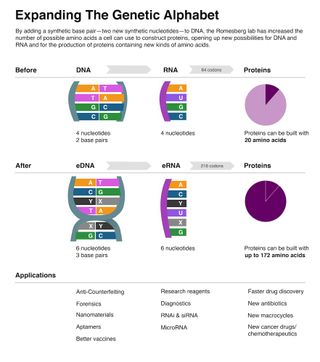Weird Engineered Organism Has 6-Letter DNA

The first report of a bacterium whose genome contains man-made DNA building blocks opens the door for tailor-made organisms that could be used to produce new drugs and other products.
All living creatures have a DNA "alphabet" of just four letters, which encode instructions for the proteins that perform most of the key jobs inside cells. But expanding that alphabet to include artificial letters could give organisms the ability to produce new proteins never seen before in nature.
The man-made DNA could be used for everything from the manufacture of new drugs and vaccines to forensics, researchers say.
"What we have done is successfully store increased information in the DNA of a living cell," study leader Floyd Romesberg, a chemical biologist at The Scripps Research Institute in La Jolla, California, told Live Science. Yet many steps remain before Romesberg and his colleagues can get cells to produce artificial proteins. [Biomimicry: 7 Clever Technologies Inspired by Nature]
DNA alphabet
The field of synthetic biology involves tinkering with DNA to create organisms capable of novel functions in medicine, energy and other areas.
The DNA alphabet consists of four letters, or bases: adenine, thymine, guanine and cytosine (A, T, G and C). Adenine pairs with thymine, and guanine pairs with cytosine. RNA is a genetic material similar to DNA, except it has a different chemical backbone and replaces the base thymine with uracil (U).
Sign up for the Live Science daily newsletter now
Get the world’s most fascinating discoveries delivered straight to your inbox.
Living things translate DNA into proteins through a series of steps. First, enzymes "transcribe" the DNA into RNA. Then, structures called ribosomes translate the RNA into proteins, which are made up of strands of molecules called amino acids.
Ultimately, the researchers aim to create organisms that can produce artificial proteins. But first, they need to show that the DNA containing the man-made letters can be transcribed into RNA, and that this RNA can be translated into proteins.
In the study, Romesberg and his team created an new pair of DNA letters not found in nature and inserted the pair into cells of Escherichia coli bacteria. Getting the DNA into the cells is not easy, but the researchers were able to do it by way of a transporter, a protein that moves materials across cell membranes.

Inside the cells, the man-made DNA got spliced into a plasmid, a circular piece of DNA found in bacteria. The plasmids replicated, without rejecting the foreign DNA or affecting the cells' growth, the researchers reported.
Now that the scientists have demonstrated an organism can incorporate artificial DNA letters into its genome, the next step will be showing it can convert the DNA into new proteins, which could be used to produce better drugs.
Custom-made drugs
Proteins have become an important new type of drug, because cells can do the work of making them and because molecular biology techniques can be used to help proteins "evolve" to have desired properties, Romesberg said. But proteins are limited to only 20 building blocks, known as amino acids.
"Compare this to a medicinal chemist, who explores a much greater diversity of structures in the small-molecule drugs they synthesize," Romesberg said. "We hope to be able to combine the best of both small-molecule and protein drugs."
The research paves the way for "designer" organisms with custom-made genomes that are capable of performing useful tasks, like making drugs. Already, researchers have created the first "synthetic organisms" — artificial bacteria and yeast — which have man-made DNA sequences in their genomes.
The researchers are now working on expanding the DNA alphabet of yeast cells, and eventually hope to do the same for mammalian cells, which have properties that make them better at producing protein drugs. Expanding the genetic alphabet of an entire multicellular organism such as a human wouldn't be possible with the current technique, however, because the artificial letters must be directly inserted into each cell, Romesberg said.
Editor's Note: This article was updated at 9:15 a.m. ET May 8, to correct a typo. RNA gets translated into proteins, not DNA.
Follow Tanya Lewis on Twitter and Google+. Follow us @livescience, Facebook & Google+. Original article on Live Science.

Most Popular

